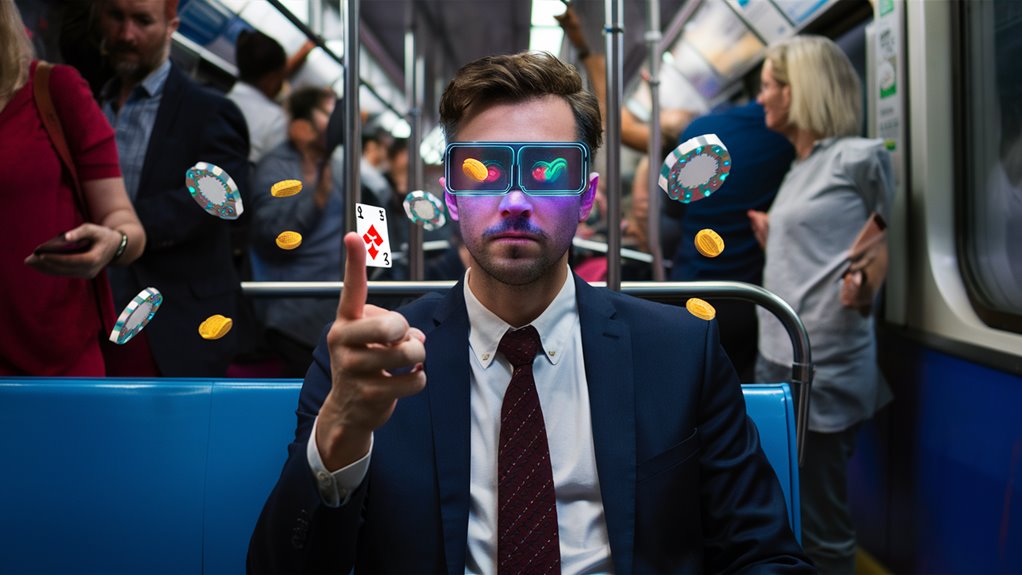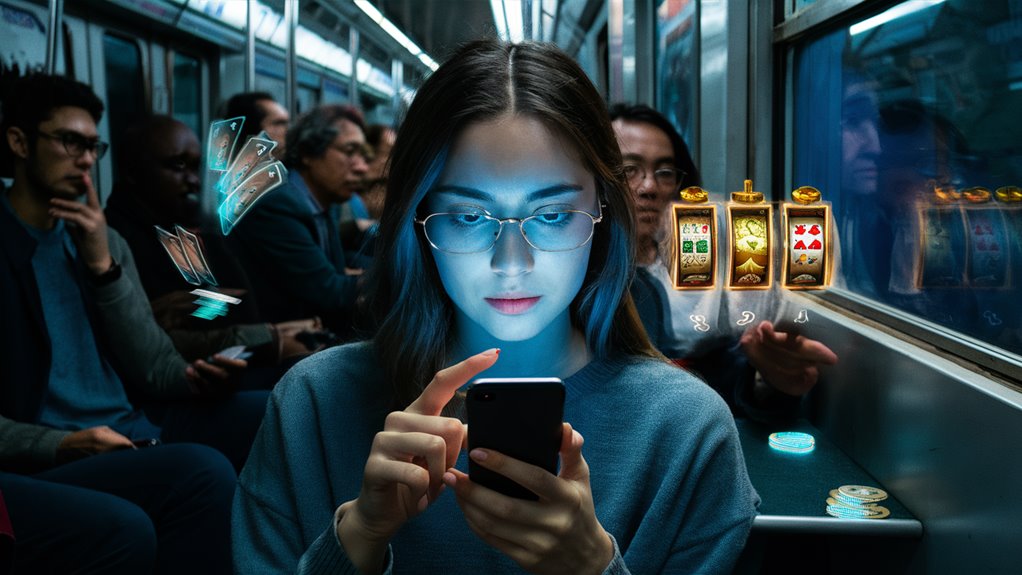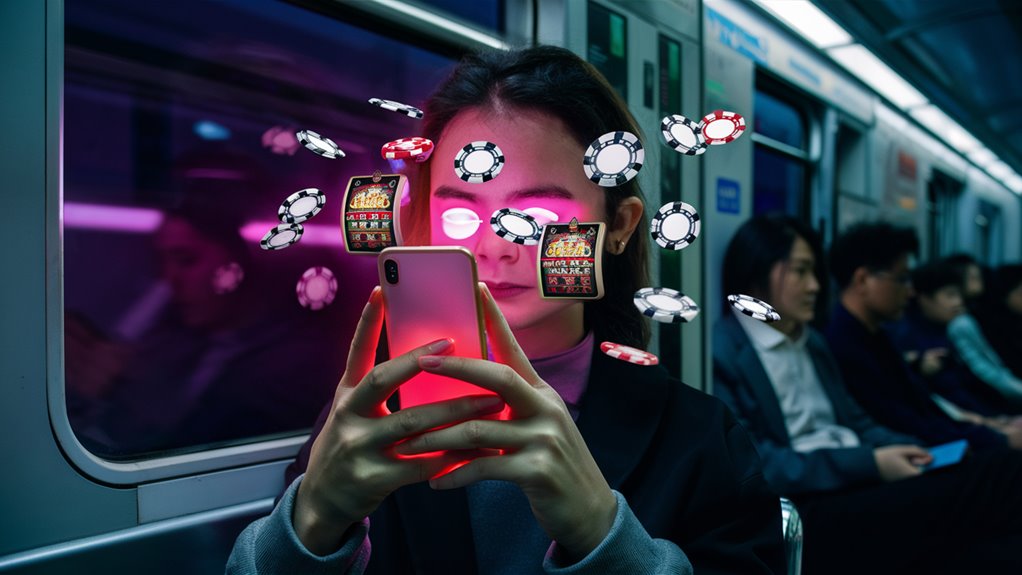
Read Time:3 Minute, 18 Second
출퇴근 중 증강현실 카지노 게임의 중독 잠재력에 대한 비판적 분석
신경학적 영향 이해하기
증강현실(AR) 카지노 게임은 출퇴근 시간 동안 도파민 반응을 기존 도박 방식보다 최대 200% 증가시키며 중독 위험을 크게 높인다. 이러한 뇌 활동의 증가는 코르티솔 상승과 정신 피로가 동시에 발생하는 시점에 나타나며, 중독을 유발하는 이상적인 조건을 만든다.
중독을 유발하는 기술적 요소
- 몰입형 3D 시각화와 햅틱 피드백 시스템이 강력한 신경 경로를 형성
- 위치 기반 보상 메커니즘이 예측 가능한 이동 패턴을 활용하여 습관화 가속
핵심 구성 요소:
- 실시간 환경 통합
- 동기화된 보상 제공
- 상황에 맞는 베팅 기회

사회적·직업적 영향
연구에 따르면 모바일 AR 도박 사용자 중 73%가 실제 사회적 상호작용 감소를 경험한다. 그 결과는 다음과 같다:
- 직장에서의 생산성 저하
- 대면 소통 감소
- 전문적 관계 손상
규제 과제 및 안전 조치
AR 기술과 전통 도박 메커니즘의 결합은 전례 없는 규제 문제를 야기한다:
- 국경 간 규제 집행 어려움
- 연령 확인의 복잡성
- 디지털 자산 규제 미비
- 실시간 거래 모니터링 필요성
예방 전략
효과적 대응책을 개발하려면 다음 요소를 고려해야 한다:
- 이용 시간 제한 기능
- 위치 기반 차단 기능
- 신경 패턴 중단 설계
- 사회적 지원 시스템 연계
AR 도박 기술과 출퇴근 루틴의 융합은 공중 보건 및 규제 당국의 즉각적인 개입을 요구한다.
AR 카지노 게임 기술 이해하기
핵심 기술 구성 요소
- 고급 AR 디스플레이 시스템: 스마트 디바이스 및 AR 글라스를 통한 시각화
- 실시간 추적 기술: 가속도계, 자이로 센서, 고해상도 카메라의 데이터 융합
- 인터랙티브 게임 소프트웨어: 실시간 환경 렌더링, 보안 난수 생성기, 결제 시스템 통합
향상된 게임 기능
- 3D 공간 오디오
- 햅틱 반응 시스템
- 실시간 멀티플레이어 기능
- 동적 오즈 조정 기능

출퇴근 심리와 도박 행동
출퇴근 중 AR 도박 행동의 형성 원인
- 반복적인 이동 중 정신적 피로
- 밀폐된 차량 환경
- 일정 시간대에 보상을 추구하는 경향
- 일상 루틴 중 도파민 민감도 증가
출퇴근 시간에 최적화된 참여 설계
- 위치 기반 트리거: 주요 노선에 맞춘 보상 시스템
- 시간 창 최적화: 출퇴근 시간대 집중
- 여정 연동 보상: 이동 시간에 맞춘 리워드 제공
행동 조건화 및 중독 형성
- 고정된 이동 시간에 노출 반복
- 노선별 도박 습관 형성
- 마일스톤 보상 시스템
이동 중 디지털 도파민 반응
AR 게임의 신경학적 영향
연구에 따르면 출퇴근 중 다음 시점에서 도파민 반응이 극대화된다:
- 게임 플랫폼 최초 접속 시
- 아깝게 놓친 상황(near-miss) 발생 시
- 패턴화된 보상 전달 시점
이동 환경 기반 보상 메커니즘
- 속도에 반응하는 콘텐츠
- 실시간 환경 매핑 오버레이
- 시간 동기화된 보상 시스템
출퇴근 스트레스와 보상의 융합 효과
- 코르티솔 상승 + 디지털 보상 타이밍
- 동적 난이도 조정
- 이동 시간 기반 루프 설계
- 움직임 반응형 보상 시스템
모바일 도박의 사회적 영향
공공 공간의 변화
AR 카지노 앱은 공공 공간을 개인 도박 구역으로 전환시킨다. 실생활 상호작용보다 가상 도박 환경을 우선시하는 경향이 강화된다.
사회적 연결 방식의 변화
- 디지털 도박 커뮤니티 확장
- 공유 기능 및 업적 시스템으로 마케팅 자발화
- 대면 인간관계의 감소
행동 변화와 접근성의 문제
- 24시간 접근 가능성으로 도박 습관이 일상화됨
- 감시 및 개입이 어려워짐
- 공동체 기반 감시망 약화
장기적 사회 구조 변화
- 업무 성과 감소
- 개인 관계 악화
- 가상 도박 커뮤니티 중심 재편
- 전통적 지지체계와의 단절

AR 도박에 대한 규제 과제
규제 체계의 한계
- 가상 환경과 물리 공간의 융합이 규제 사각지대를 형성
- 국가 간 이동 중 실시간 게임 참여로 관할권 문제 심화
핵심 규제 공백
- 연령 확인 어려움
- 가상/현실 통화 통합 시 불투명성 증가
- 책임 도박 수단 적용 어려움
- 지오펜싱 기술의 정확성 부족
관할권 및 기술적 해결책
- 다중 규제 지역 대응을 위한 추적 시스템 필요
- 지속 가능한 준수 시스템 개발 필요
- 플랫폼 모니터링 기술 고도화 필요
AR 카지노의 예방 및 피해 저감 전략
필수 보호 기능
- 지출 한도 강제 시스템
- 위치 기반 차단 조치
- 현실 점검 알림 자동화
AI 기반 감시 및 개입 시스템
- 베팅 패턴 및 손실 추적 실시간 분석
- 위험 지표 탐지 시 자동 쿨링오프 개입
- 상담 지원 시스템과 즉시 연결
사용자 보호 프로그램 강화
- 생체 인증 기반 자가차단 강화
- 사전 한도 설정(금액/시간)
- AR 인터페이스를 통한 실시간 상담 접근성 보장
핵심 예방 구성 요소
- 지출 제한 강제
- 플랫폼 간 차단 프로토콜
- 행동 패턴 모니터링
- 실시간 개입 시스템
- 강제 쿨링오프 기간 설정
- 위치 기반 도박 제한
- 통합 상담 서비스 연계
이러한 전략적 시스템은 AR 환경 내 도박 중독의 위험에 노출된 사용자를 보호하는 견고한 안전망을 형성하며, 동시에 게임의 건전성을 유지할 수 있도록 설계되어야 한다.





